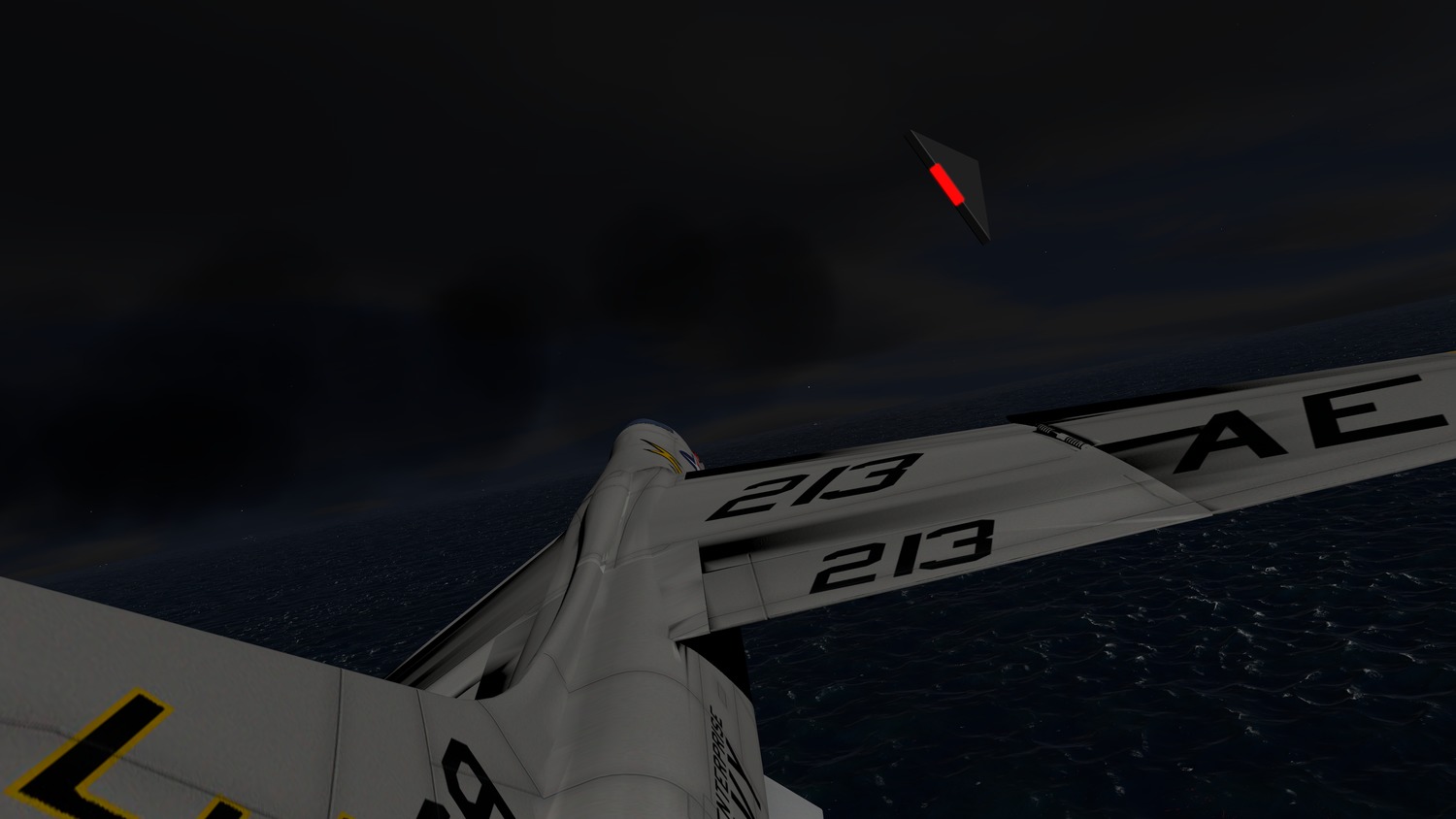
Artistic Rendition of the USS Gyatt “UFO Encounter” in 1964. (Image Credit: Dave Beaty of the Nimitz Encounters)
On October 31, 1968, the University of Colorado submitted its final report on the Scientific Study of Unidentified Flying Objects.
After 18-months of scrutiny, the ad-hoc commission led by physicist Edward Condon said, “careful consideration of the record as it is available to us leads us to conclude that further extensive study of UFOs probably cannot be justified in the expectation that science will be advanced thereby.”
On January 8, 1969, when the New York Times broke the news of Condon’s findings, the “dean of science writers,” Walter Sullivan, sardonically labeled any who rejected the conclusion as “UFO enthusiasts.” In a follow-up article the next day, Sullivan added “Believers” to the veiled epithets for those who dared to stubbornly hold mystique for a topic that could be entirely explained by prosaic means.
For many of those “UFO enthusiasts,” including some who had initially worked on the project, the University of Colorado’s study was little more than a hitman sent forth by the Air Force to assassinate the UFO subject and end public discourse on the subject of mysterious airborne objects.
Successful in their bounty, less than a year after Condon’s conclusion, the Air Force shuttered its 21-year systematic study of UFOs – Project Blue Book. With this, the US government unceremoniously stepped away from an issue that had become an unsightly distraction to the socially turbulent 1960s and seething Cold War with the Soviet Union.
In an analogous throwback to modern complaints of “fake news;” intriguingly, Sullivan’s remarks, along with all the press stories on the Condon Report’s determination, were based on admittedly “fragmentary accounts of the principal conclusion” and a verifiably diluted 11-page summary that had been “leaked” to the Associated Press.
Exceeding Leo Tolstoy’s War and Peace by more than 250-pages, it’s easy to assume few, if any, of the press would later read Condon’s entire 1485 page anthology. In fairness, any lack of consumption can not be attributed to lack of availability. As if torn from the egodystonic pages of an Aesop fable, in February 1969, the New York Times/ Bantam Books published and sold copies of the complete Condon Report. Even including “an exclusive introduction” by none other than Walter Sullivan.
Nevertheless, offering near-universal praise for the report and the government’s closing of Project Blue Book, as chief prosecutor in the court of public opinion, the news media helped shape what would be the social sentiment towards UFOs for generations to come.
To the accepted majority, the Condon Committee represented the last accepted scientific study of UFOs. The perception of Condon’s conclusions became the tipping point for the topic to be relocated to a place of no real value outside of entertainment.
For their part, UFOs were seemingly unconcerned with the social sentiment. Not only did sightings post-Condon fail to stop, but the frequency of likely misidentifications vs. unexplainable sightings continued at a remarkably consistent rate as Project Blue Book had recorded during its nearly two-decades of operation.
With a propensity toward sporadic airborne displays, these Unidentified Flying Objects seemingly transcended all cultural, ideological, and geographical boundaries. Their only outward consistency appeared to be an unwavering commitment to rejecting current paradigms and generally behaving in ways that seemed entirely alien to human understanding.
However, both the actual and alleged sightings of mysterious airborne objects became a moot point. Public consensus had accepted the argument from authority. The disconnect between the observed and the observer only widened, and the “UFO Enthusiast” became regulated to society’s fringe. For scientists, academics, pilots, government employees, or generally anyone who desired a reputable professional stature, to be associated with having an interest in UFOs became a fatal albatross.
Consequently, thanks to being unbridled by credentialed authority, over the ensuing decades, “UFO Enthusiasts” evolved into a “community” and largely conformed to cultural status exacted upon it. The five cities of refuge for “UFO enthusiasts” were located in the lands of magical thinkers, crackpots, paranoid conspiracists, subjective “experiencers,” and a rare reclusive band of nihilistically curious.
In a rather ironic twist, 48-years and a day to when the Air Force closed down Project Blue Book, a brazen challenger to the UFO status quo unexpectedly emerged.
In arguably the most significant mainstream event for the UFO topic in nearly 50-years, on December 16, 2017, the New York Times revealed an obscure program within The Pentagon called Advanced Aerospace Threat Identification Program or AATIP. Reportedly, this shadowy program had secretly been investigating UFOs under the guise of former senior DoD official, Luis Elizondo. Complementing the Time’s expose, were three DoD videos depicting what The Pentagon would later formally acknowledge was “Unidentified Aerial Phenomena” or UAP.
Entirely new generations of people and government appendages suddenly re-discovered the decades-old UFO enigma.
By summer of 2020, the DoD acknowledged it had an officially backed task force to examine UAP. The chief political overseers of America’s Intelligence Community, the Senate Select Committee on Intelligence, had, through legislative decree, asked the Director of National Intelligence to provide a comprehensive report on how the government is handling UFOs. By early May of this year, the Office of the Inspector General had even announced they too would be throwing their hat in the ring and evaluating the DoD’s “actions regarding Unidentified Aerial Phenomena.”
Sitting Senators, former directors of the CIA and National Intelligence, former presidents, and even NASA have all since come forward suggesting that something mysterious is apparently soaring through the skies with impunity.
Is this current UFO blitzkrieg simply fueled by the unbridled fantasies of rebellious “believers,” as Condon reportedly implied over five decades ago? Considering some of these “believers” have held, or currently hold, pinnacle positions in the halls of American power, this is frankly more alarming than any foreseeable UFO reality.
In this four-part series, The Debrief will explore the lives of several individuals and how the UFO subject has influenced them. Each person represents different rungs on the ladder of U.S. military power. Their unanticipated experience with the UFO subject spans nearly 60 years.
In this endeavor, The Debrief wanted to see if there was any truth to be had with the UFO subject or if the Condon Committee’s now 52-year-old conclusion still applied.
Ultimately, we would discover Condon’s conclusion was, surprisingly, very much correct. That conclusion, however, isn’t what most people think and has been largely overlooked.
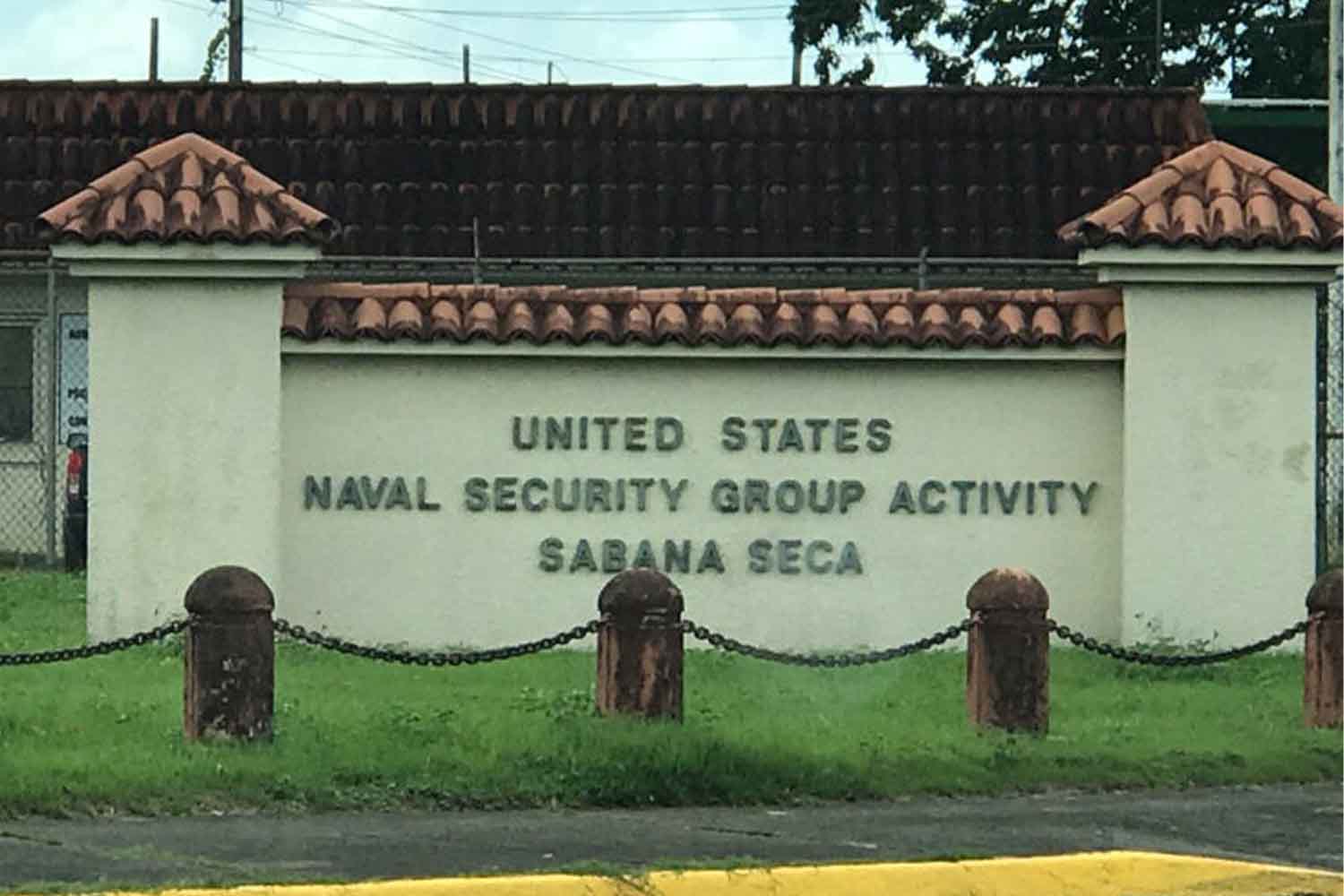 Sign at the entrance of Naval Security Group Activity Sabana Seca, Naval
Base in Toa Baja, Puerto Rico. (Image Credit: Wikicommons)
Sign at the entrance of Naval Security Group Activity Sabana Seca, Naval
Base in Toa Baja, Puerto Rico. (Image Credit: Wikicommons)
Part I : Mystery in the Caribbean
Originally a pineapple and grapefruit plantation before the U.S. Army converted it into a munitions depot during WWII; roughly 14 miles west of cobblestoned Old San Juan, Puerto Rico, is an inconspicuous 2,250 acres that has quietly served as one of the epicenters for America’s covert signals intelligence collection.
Verbosely titled- Naval Security Group Activity Sabana Seca (NSGA), Naval Base- for at least five decades, the site served as a nerve center for spying on communications coming out of Latin America and the Caribbean. Officially NSGA Sabana Seca closed down in 2003. However, leaked documents show the NSA and CIA were still using this patch of tropics for signals intelligence as late as 2013.
Ironically, recent history’s most famous UFO canary, former senior Pentagon official Luis Elizondo, was likely once stationed at NSGA Sabana Seca. According to public records, this would have been in the early 2000s, when Elizondo was working for one of the Intelligence Community’s surreptitious provinces. Years before he’d find himself being drawn into UFOs and the now infamous AATIP. Though Elizondo will neither confirm nor deny if this is true.

Richard “Lee” Walther in Puerto Rico in the early 1960s. (Image Source: Richard “Lee” Walther)
Regardless, in the mid-1960s, a young Navy cryptologist and Petty Officer Second Class, Richard “Lee” Walther, would indeed find himself working out of the reclusive NSGA Sabana Seca.
Nearly 2,000 miles from his hometown of Egg Harbor City, New Jersey, Walther had arrived at the spy post in October 1962 and just in time for the Cuban Missile Crisis. “Looking back on it, as a young kid, I didn’t fully appreciate what an important time in history this was. But yeah, a lot was going on for sure,” reminisced Walther in a phone call with me.
“Everything we did was classified. I held a Top Secret clearance, and everything we did was on a need-to-know basis,” Walther recalled his time working at Sabana Seca’s ‘Radio Shack.’”
“I was classified as an A branch or Administrative, but I did most of my work in the interpretive branch division, where we had a bunch of linguists, Portuguese, Russian, and of course Spanish. Back then, we were looking for foreign intelligence to try and figure out what the enemy might be doing to us or around us.”
The gravity of the United States and Russia threatening to plummet the world into nuclear armageddon may not have fully sunk in for the young Walther. However, a series of mysterious events in the fall of 1964 has since plagued him for over 50 years.
“Among the things we did was to monitor a lot of air traffic and radio communications all over the area. This included receiving dispatches periodically from ships that were stationed in the greater Caribbean Sea. In late summer and fall, of 1964, we began receiving reports of UFO sightings and activity involving both Navy and Air Force pilots in the area,” divulged Walther.
“This UFO business sort of came out of the blue. I remember it was the subject of some laughter and joking. A few of us who were, you know, neutral on it didn’t know what to think of it. And that’s where I am today. But with this USS Gyatt business, I really don’t know what to make of it.”
With a remarkably sharp memory, the now 77-year-old Walther told me how in late November 1964, his supervisor shared with him the remarkable details of something inexplicable that had been vexing several Naval ships off the coast of Puerto Rico, including the Gearing-class destroyer: The USS Gyatt.
“Richard Yeck was the Lieutenant I worked with most closely, and he was the one who made me aware of this whole USS Gyatt business. That’s how I got my hands on the material. We had a very strict policy that nothing came in and nothing went out of the ‘Shack.’ But this UFO stuff was an outlier, so Lt. Yeck gave me the green light to hold on to the materials.”
Walther had been allowed to keep copies of two group traffic intelligence reports filed by Navy San Juan Operations Officer, Captain William. R. Sisley. During the Korean War, Capt. Sisley had been squadron commander of Strike Fighter Squadron 83 (VFA-83), the “Rampagers.”
Walther shared with me copies of these original onion-skin intelligence reports that he’d been holding onto for almost six decades. Totaling only 4pages, they offered a glimpse into a remarkable series of events that have since become less than a footnote in the annals of history.
Perplexing records, including visual and radar observations of a series of unexplained encounters that sound eerily similar to a more recent UFO event occurring in 2004 off America’s West Coast and now famously known as the “Nimitz Encounters.”
“It wasn’t simply the visual and radar contacts by the pilot. There were radar operators on the ship who tracked this thing as well. Over days, not just one episode. It was an ongoing series of events,” remarked Walther.
“Hopelessly Outclassed”
Message traffic reports reveal over several nights in late November 1964, the USS Gyatt- named for 22-year-old Marine Corps Private Edward E. Gyatt, who was killed during a Japanese counterattack during the Battle of Guadalcanal in World War II -began picking up radar tracks of an unidentified bogey over the Atlantic Ocean near Puerto Rico.
On successive nights of November 16, 17, 18, 19, and 24th, radar stations aboard the USS Gyatt and at the Norfolk Test and Evaluation Detachment started showing an unidentified aircraft, seemingly capable of operating a both very slow and at significantly high speeds, while also being able to maneuver at high and at “low-level” altitudes.
On November 18, one report details, radar operators tracked the unidentified contact for approximately 8 nautical miles. At one point, it “appeared to be a low flying target” while passing directly over the nuclear-powered guided-missile cruiser USS Bainbridge and traveling at only 180 knots or 207 mph. “Intercept attempted. However, the target faded,” reads the report.
On the evening of November 19, the USS Gyatt once more detected the unidentified aircraft, this time traveling at Mach 1.03 or 788 mph and roughly 60 nautical miles north of Puerto Rico and rapidly closing in on the island.
Unlike previous nights, an F-8 Crusader from Utility Squadron Eight (VU-8), stationed at Roosevelt Roads Navy Base, was already airborne when radar operators picked up their unknown nemesis. Apparently tired of being taunted by the interloper, the USS Gyatt ordered the F-8 to perform an intercept.

Lieutenant Commander Kyle H. Woodbury. (Image Source: The National Archives)
Piloting the F-8, callsign “Salty Spray 26,” was VU-8’s Executive Officer, Lieutenant Commander Kyle H. Woodbury. Reports sent on November 26, 1964, from Ramey Air Force Base in Aguadilla, Puerto Rico, to NORAD and Air Force Headquarters at the Pentagon described Lt. Cdr. Woodbury as “Reliable” and as having “extensive flying and jet experience.”
At an altitude of 35,000 feet, Woodbury told air traffic controllers he had a visual of the “high altitude and very high-speed object.” Favored by clear weather, good visibility, and a full moon, Woodbury described the “stranger” as a black or dark grey triangular or “delta-shaped” aircraft, roughly 60 feet in length. Woodbury said the aircraft was silent, with no exterior lights, except for a single bright light source or “cone shape fire” that would emit from the vehicle’s tail during periods of acceleration.
Woodbury and Gyatt radar operators watched as the categorical UFO made “numerous changes of course” before “steading down abeam to the jet’s 9 o’clock position, paralleling the F-8 at a distance of 9 nautical miles.” Turning the Crusader 90 degrees to port and selecting afterburners, Woodbury climbed to 50,000 feet to close the gap between him and the UFO.
Reaching to within 5 miles of the target, Woodbury would report the object “accelerated at extremely high speed” while turning in a wide starboard turn and climbing an excess of 50,000 feet and out of sight. In his report, Capt. Sisley quoted Woodbury as saying that his F-8, which had a maximum performance speed of Mach 1.6 or 1,227 mph, had been “hopelessly outclassed.”
In a report filed several weeks later by Norfolk Test and Evaluation Detachment, Woodbury said,
There is no reasonable explanation for this target. Its speed, acceleration, ceiling, and ability to decelerate exceed any aircraft I have ever seen or heard of.”
Woodbury would also add, “I would evaluate target as aircraft, very high performance, maneuvered as an aircraft and performed no unusual maneuvers except, extreme acceleration and de-celleration at will, plus a very steep climb angle in excess of 50,000 feet at high speed.”
Ironically, during the 1964 encounters, the USS Gyatt had been testing the Raytheon AN/SPS-49. At the time, the SPS-49 was beyond cutting-edge, and it wouldn’t be for another 11 years that the long-range two-dimensional air search radar would be introduced to the rest of the U.S. naval fleet. A highly-updated variant of the AN/SPS-49 is still used by some classes of Navy ships today.
On November 19, Gyatt radar operators using the SPS-49 tracked the mysterious aircraft, including 10 minutes of Woodbury’s attempted intercept of the UFO. A series of 19 photographs of the Gyatt’s radar scopes, still stowed away at the National Archives, offer evidence in support of the erratic maneuvers Woodbury had described.
In a puzzling series of frames, radar shows the target traveling at 926 mph before abruptly slowing to 632 mph. Later analysis by the Air Force’s Foreign Technology Division (FTD) suggested this was when Woodbury’s jet and the UFO “merged plot,” meaning the two aircraft were too close to each other for the radar to differentiate between them.
The aircrafts reappeared as separate targets on the radar’s next pass. Only now, the unidentified target was climbing above 50,000 feet at 1,743 mph. The last contact with Gyatt radar operators showed the unknown aircraft continuing into the stratosphere at 1,035 mph.
Abandoning pursuit, Woodbury plotted a course back to Roosevelt Roads Naval Station when the high-performance interloper reappeared and began trailing behind him. The UFO was seemingly playing a game of cat and mouse with the fighter pilot.
On November 24, the enigmatic aerial trickster, yet again, showed up on the Gyatt’s radar screens. Capt. Sisley’s message reports, “AFWR [Atlantic Fleet Weapons Range] had HI SPD, HI ALT target which pulled away rapidly from F-8 at Mach .99 and 45 Thousand [feet in altitude].”
Two days after Sisley’s messages, the 72nd Bomber Wing at Ramey Air Force Base announced the mysterious UFO events to numerous Air Force offices, including the 32nd Air Division (NORAD), USAF HQ Washington, DC, the Office of Special Investigations, and the Foreign Technology Division at Wright Patterson AFB. At the time, FTD had been the home of the Air Force’s official UFO investigators and Project Blue Book. “The Navy has become quite concerned with this, and I think a more thorough investigation is needed,” reads the message.
On November 27, Major Hector Quintanilla, head of Project Blue Book, acknowledged receipt of the message, saying, “preliminary analysis of the UFO report indicates that the object tracked by radar and sighted visually by Commander Woodbury is not a UFO, but an unidentified aircraft.”
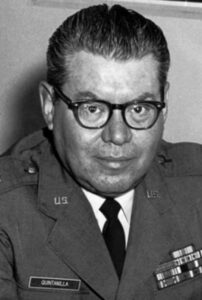
Major Hector Quintanilla, head of Project Blue Book. (Image Source: The National Archives)
Commissioned as a Second Lieutenant in the Air Force in 1951, Quintanilla had been a communications officer in charge of a radio traffic analysis group until 1963, when he was asked to take over the Air Force’s fledgling UFO study. Quintanilla would end up being the longest-serving and final director of Blue Book, commanding the program until it’s 1969 closure.
The “Quintanilla Era” has been criticized as the least credible years of Blue Book’s 17-year history. Quintanilla’s repeated conclusions that reports of odd aerial objects were nothing more than bright stars or planets led critics, including many scientists, to suggest Project Blue Book’s research was, at best, questionable, at worst, perpetuating a “cover-up.” Physicist and University of Arizona professor of meteorology, James E. McDonald, bluntly said Quintanilla was “not competent from either a scientific or an investigative perspective.”
Interestingly enough, Quintanilla seemingly agreed with McDonald’s assessment. In his memoir, published after his death in 1998, Quintanilla said the only qualification he met for directing Blue Book was that he had a physics degree from St. Mary University. Retiring as a Lieutenant Colonel after the program’s closure, Quintanilla said his appointment to Blue Book might have been a punishment for turning down several other jobs in the escalating Vietnam War.
It can be argued that the preliminary analysis that the USS Gyatt incidents were not a UFO but rather an unidentified aircraft was simply Quintanilla stating the null hypothesis. This approach would be consistent with the scientific method of solving problems. Yet, it would also be in contrast to the best-method practices of investigation.
Quintanilla’s preliminary analysis was based on the 72nd Bomber Wing’s 4-page memo, which offered a generalized overview of incidents that had occurred over multiple days and involving multiple personnel. His view came a day before the USS Gyatt had even arrived back at port in Virginia with the radar images in hand. Quintanilla and Blue Book wouldn’t get copies of the photos from the Defense Intelligence Agency and Lt. Cdr. Woodbury’s more detailed report from Norfolk until December 3.
In essence, Quintanilla was stating the preliminary hypothesis for a problem that hadn’t been well defined. Of course, Quintanilla’s willingness to communicate a conclusion before seeing the whole problem may be more indicative of the system he was working in than his competence.
A little over a week after Blue Book received the relatively sparse details of the Gyatt’s UFO woes, the Pentagon was already pressing for answers. “Continued high-level interest in this incident. Has further analysis been conducted by FTD of this incident? Are you in a position to state with finality that this incident was not one involving UFO,” reads a memo by Air Force Chief of Staff’s Office to Quintanilla on December 8, 1964.
Later that same week, on December 11, 1964, U.S. Air Defense Command sent a classified memo to the Air Force Chief of Staff and FTD saying, “No operational test flights of projects known to this command, including the YF12A or high-speed drones, scheduled at time or place of incident.”
On the same day, DIA and FTD analysts said they had determined the bogey did not exceed 1515 knots, or 1743 mph, and had an average acceleration of 1380 mph. A joint message reads, “unable to explain [the] estimated speed of 3800 knots reported in UFO message from 72 Bomber Wing.”
Where this oddly specific speed of 3800 knots came from isn’t entirely clear. Another December 11, 1964 memo from the 72nd Bomber Wing to FTD emphasizes that the UFO was tracked at an estimated 3800 knots or 4,373 mph. Assumingly, this estimate came from Woodbury’s attempted to intercept, but that is never expressly defined in the reports.
Nowhere in any of the surviving reports from Blue Book, the DIA, or Air Force is there any mention of the radar tracks and at least one other attempted intercept on the nights of November 16, 17, 18, and 24. Likewise, other than Norfolk’s interview with Woodbury on December 3, there’s no evidence that Quintanilla, or anyone for that matter, ever spoke with the radar operators or the other pilot who attempted the intercept.
Finally, no accompanying information establishes how familiar DIA and FTD analysts were with AN/SPS-49 radar. In 1964, the Gyatt’s SPS-49 was literally one-of-a-kind. In fact, even contemporary naval records say the Gyatt began testing the SPS-49 in 1965 and make no mention of the radar being used to track a UFO the year prior.
Notwithstanding these lingering questions, on December 19, 1964, Quintanilla submitted his conclusion to the Air Force Secretary’s office.
Confirmed A/C [aircraft]. Reported high-speed not confirmed from scope photos. Speeds indicated in [the] initial report were in error.”
Since communications only described the unknown aircraft as “very high speed,” assumingly, the agreed-upon speed of nearly 1,800 mph did not meet Quintanilla’s threshold of “high speed.”
Other Project Blue Book records
clarify, by “confirmed aircraft,” Quintanilla had ruled the USS Gyatt
UFO was a confirmed “unidentified aircraft.” Its type or origin had
never been determined.
In late 1964 – when Soviet leader Leonid Brezhnev increased aid to the North Vietnamese to tie up American forces who had just begun deploying ground troops in Vietnam- an unidentified aircraft of foreign origin “hopelessly outclassing” U.S. Navy fighter planes in the Caribbean would have presumably triggered a significant response by defense intelligence.
Evidently, this assumption would be wrong.
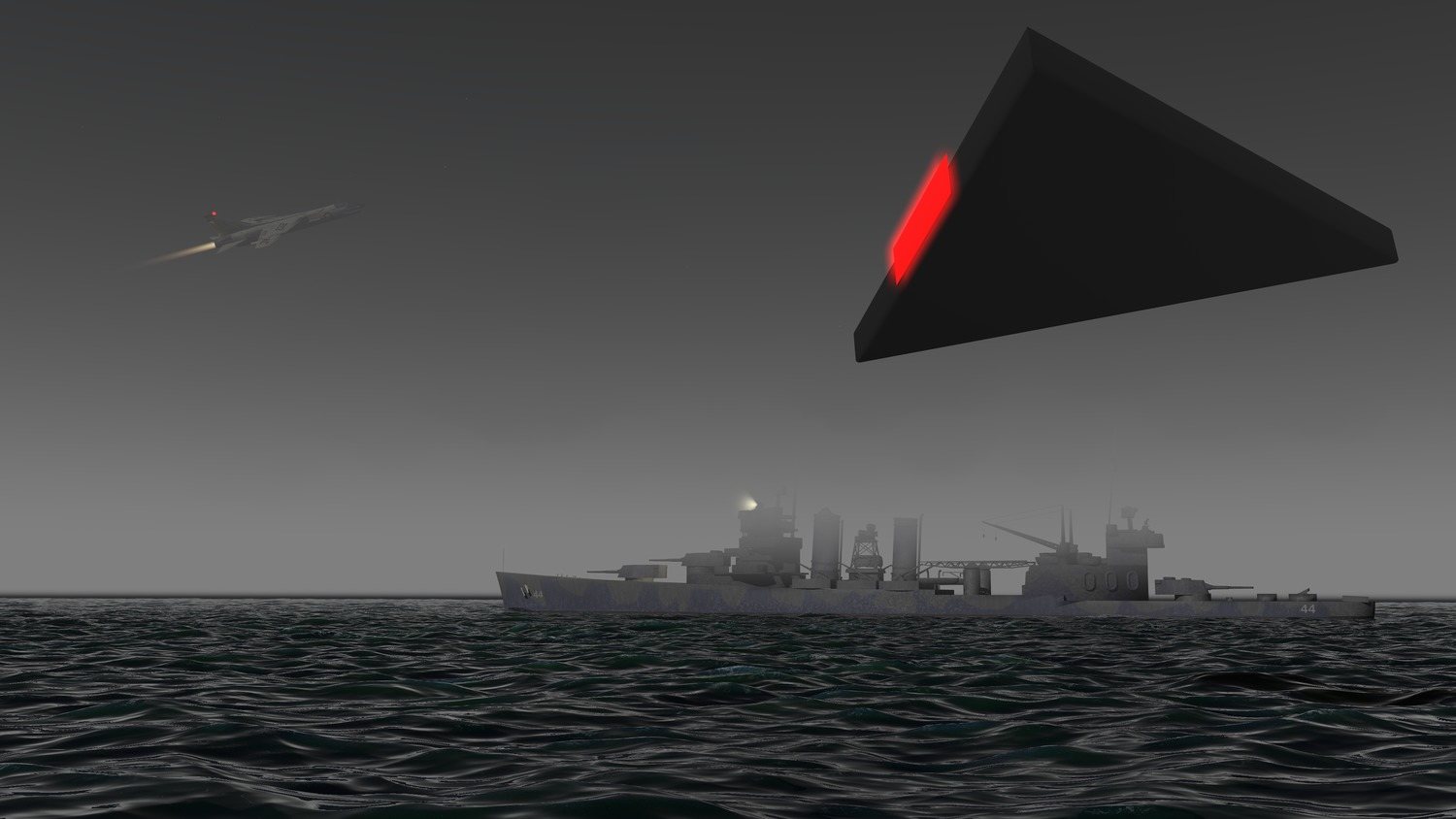 Artistic Rendition of the USS Gyatt “UFO Encounter” in 1964. (Image Credit: Dave Beaty of the Nimitz Encounters)
Artistic Rendition of the USS Gyatt “UFO Encounter” in 1964. (Image Credit: Dave Beaty of the Nimitz Encounters)
The USS Gyatt’s “Unknown Aircraft” Not UFO
No known records from the Air Force, Navy, DIA, or CIA suggest an attempt to follow-up or identify what type of aircraft was buzzing around America’s strategic strongpoint to Latin America. Now-declassified copies of the President’s Daily brief show reconnaissance images of Cuba captured by F-8 Crusaders in November 1964. Absent from these intel reports is any mention that these same F-8’s were moonlighting as UFO hunters in the evenings.
Even if U.S. intelligence agencies in the 1960s weren’t interested in solving the mystery, it should be relatively easy to narrow down who that delta-wing intruder pestering the skies near Puerto Rico might have been now. Yet, probable explanations for what the USS Gyatt encountered 57 years ago still remain elusive.
In 1964, Air Defense Command (ADC) had ruled out the YF-12A, the twin-seat prototype version of then-very Top Secret Lockheed A-12 reconnaissance aircraft. However, the YF-12 and A-12 “Archangel” were uniquely delta-shaped and capable of speeds exceeding 2,000 mph, with a service ceiling of 85,000 feet. Equally, there were operational prototypes of both high-performance aircraft by 1962.
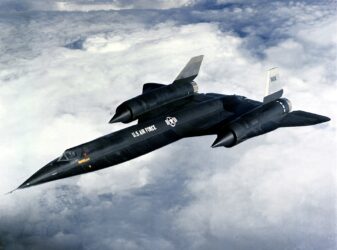
A-12 “Archangel” (Image Source: Wikicommons)
Fact-checking ADC, I reached out to radar systems expert, black budget aerospace veteran, and author T.D Barnes. Barnes had been part of the CIA recruited team of virtuosos who developed the YF-12, A-12, and later SR-71.
Backing up the previous assertion, Barnes told me in November 1964, neither the YF-12 nor A-12 would have been zooming around and taunting fellow naval forces in the Caribbean. In remarkable detail, Barnes recounted to me the A-12’s first flight outside of Area-51.
In a flight codenamed SCOTCH MIST, the A-12 flew from Area-51 to McCoy Air Force Base near Orlando, Florida, on August 4, 1965. Nine months after the USS Gyatt’s mysterious “stranger.” Before this, Barnes said, “the A-12 had flown only out of Area 51 with an altitude of 4,462 feet [and] I’m not aware of any other delta-wing aircraft at the time.”
The other problem with the A-12 or YF-12 comes from Woodbury’s description of a single bright light at the craft’s tail, which indeed sounds suspiciously like the afterburner of a performance jet. Like the SR-71 “Blackbird,” the Archangel was powered by a pair of Pratt & Whitney J58-1 turbojet engines. Woodbury would have seen two bright lights and not the single “fiery cone” he reported had it been the spy plane.
The other roughly triangular or “delta-shaped” aircraft capable of high-altitude speeds exceeding Mach 2.2, the air-launched Lockheed D-21 drone and SR-71, didn’t take their first flights until December 22, 1964, three days after Quintanilla’s conclusion. The D-21 piggybacking on the SR-71, again all shrouded from prying eyes inside Area-51.
Ruling out a secretive U.S. program – that for reasons which presently escape logic had decided to repeatedly pester its fellow sailors – that all but leaves the Soviet Union as being the only other power capable of producing a high-performance aircraft like what was described.
Though a high-swept wing and not delta-wing aircraft, by March 1964, the USSR did have at least one prototype Mikoyan-Gurevich MiG-25 “Foxbat.”
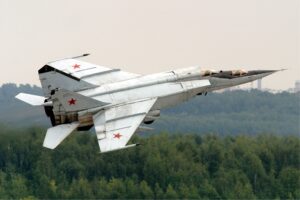
Mikoyan-Gurevich MiG-25 “Foxbat.” (Image Source: Wikicommons)
Considered one of the fastest aircraft ever built, only the A-12, SR-71, and experimental X-15, was capable of out-racing the Foxbat. However, the MiG-25’s maximum high-altitude speed rating of Mach 3.3 or 2500 mph was largely theoretical. The jet’s two Tumansky R-15B turbojet engines tended to overheat at high speeds, making the MiG-25’s actual performance speed much slower than it looked on paper. Again, like the A-12, had Woodbury been chasing a Foxbat, he should have seen two bright lights at the craft’s rear, not one.
It’s also inconceivable that 7 months after the prototype’s first flight, the Soviet Union would have had a Foxbat tooling around and harassing American forces in the Caribbean. Ultimately, the MiG-25 wouldn’t enter service until 1970, having a limited operational history before the USSR ended production in 1984.
With a slightly bemused frown, author, defense journalist, and former aviation editor of Jane’s Defence, Nick Cook, shook his head in disagreement when I asked him how likely this was a secretive Russian delta-wing performance aircraft of unknown type in 1964. More importantly, an aircraft that has somehow eluded public knowledge for nearly 60 years.
“Virtually impossible,” Cook said, before recounting to me a time just before the collapse of the Soviet Union when he was able to acquire a performance manual for the then-secret Ekranoplan wing-in-ground effect craft for a bottle of Johnny Walker whiskey.
When Project Blue Book closed shop in 1969, the USS Gyatt case was never counted amongst the handful of reports determined to be “unidentified” because it was labeled an “unidentified aircraft.”
“I was amused by their choice of terminology,” scoffed Walther. “With malice and aforethought, I’m sure they selected innocuous terminology to soften the blow if you will. Make it more palatable for readers.”
What the USS Gyatt encountered in November 1964 remains no less of a mystery today than it did almost six decades ago.
“Are we all going to die with no answers?”
For Walther, he sees parallels between the USS Gyatt’s UFO encounters in ’64 and current UFO or UAP reports that are trickling out from military pilots today.
“The performance of the bogey with Gyatt wasn’t just described by the pilots, but also tracked on highly sophisticated radar. At least top-of-the-line for back then,” said Walther. “With the more recent sightings that we know about, the equipment’s only gotten better and better, so we can say with scientific certainty that these things are real. Yet, we’re still asking ‘what is it?”
Walther stresses he didn’t hold onto the Gyatt UFO messages for decades because he’s bent on proving aliens are visiting earth. In fact, the obstinate inclination to equate “UFO” or “UAP” as being “aliens” by both “believers” and skeptics is primarily the reason why determinations such as “unidentified aircraft” become oddly hollow but satisfying conclusions.
“There’s a lot of skepticism, almost derision, of anyone who brings up the subject, let alone is a believer,” sighed Walther. “If you’re a ‘believer,’ you’re thought to be some kind of kook, and I think it silences a lot of people. Including knowledgeable pilots and people who have first-hand experience with this phenomena. It just leads to more ignorance because we’re not gathering up all of the data that’s out there and available for discussion and intelligent critique.”
I had not mentioned Walter Sullivan’s use of the phrase when Walther gave his criticism of the label “believers.” His organic rebuke of the term serves as a testament to the lasting impact words can have on collective society.
During one of our early phone conversations, Walther, who has the memory of a person you wouldn’t want to borrow money from, gave me a half-a-dozen or so names of former sailors he worked with at Sabana Seca. Scouting the list of Navy vets, most having lived full lives into their 80’s and 90’s, I’d discover all but one were now deceased.
The shameless notice that time waits for no one reminded me of something an unnamed DoD official told The New Yorker’s, Gideon Lewis Kraus. “There are guys who spent their lives studying stuff like Roswell and died with no answers. Are we all going to die with no answers?”
I asked Walther what he hoped to see happen with the government and public renewed interest in UFOs or UAP. “I’m an old man now, but I’m still bewildered by all of this stuff. There’s this cloud of skepticism if you believe this stuff occurs, and you’re a kook, and what you say is disregarded. I really have a problem with that,” Walther replied. “What we need is people to forget about their prejudices and biases, and just simply look at this kind of like it’s a challenge. Then let’s figure out what’s going on here.”
Tim McMillan
No comments:
Post a Comment
Note: Only a member of this blog may post a comment.